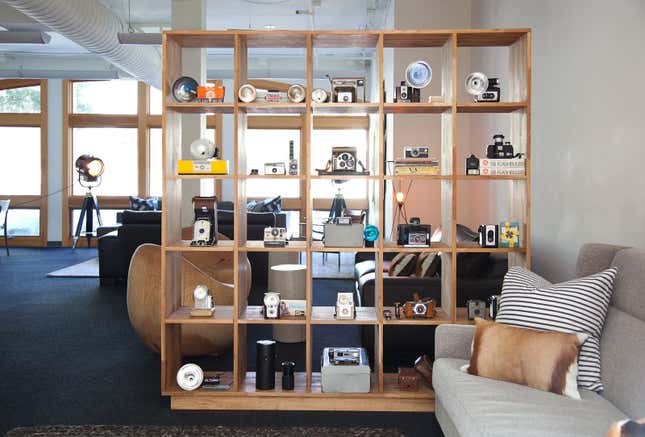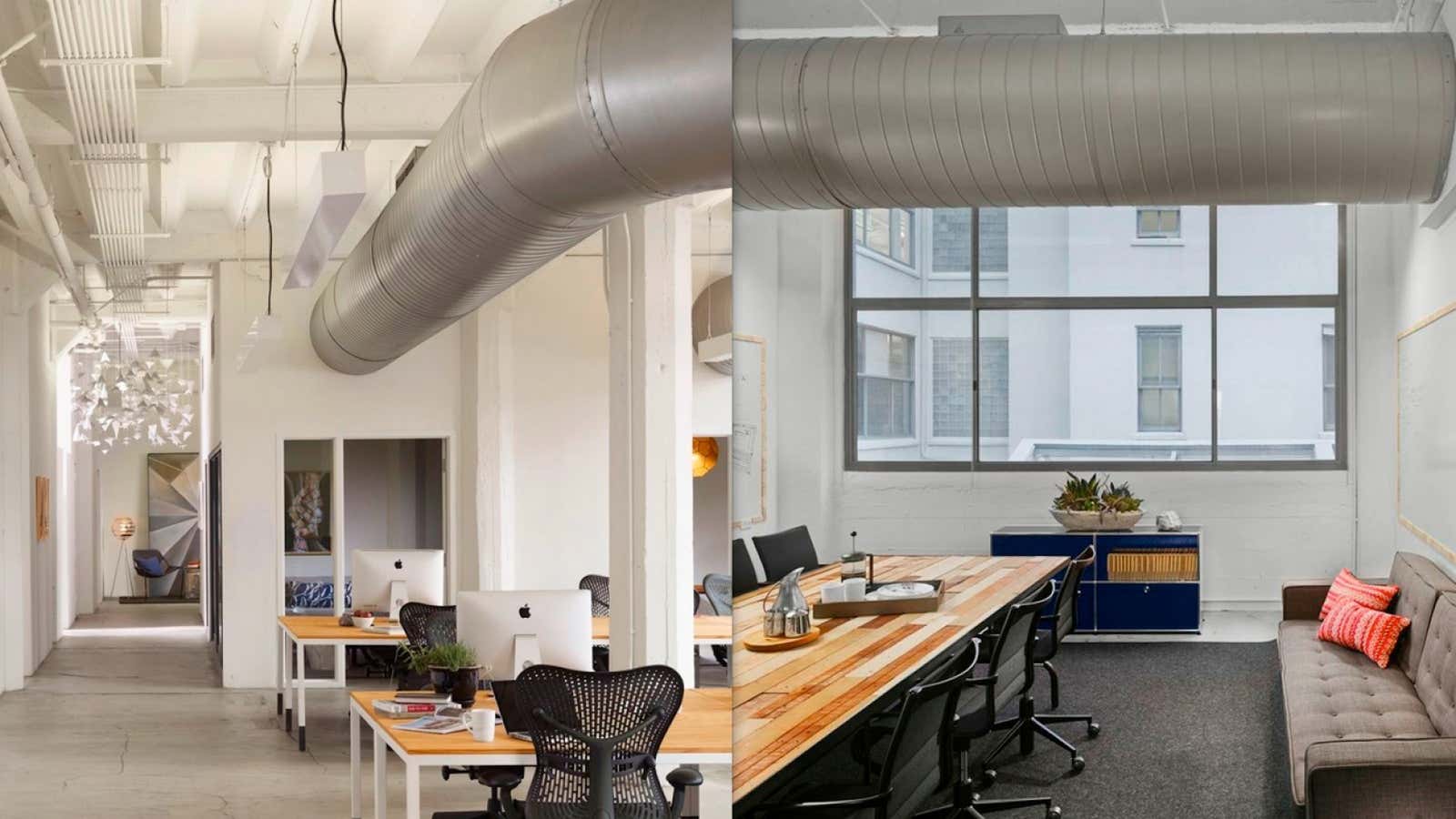Lauren Geremia has designed interior office spaces for US technology startups including Dropbox, Instagram, and Hightail (formerly known as YouSendIt.) She founded her firm, Geremia Design, in 2010 to change the way employers think about office design.
Geremia, 31, says the increased attention that companies, especially tech startups, are paying to workplace design is indicative of new incentives for employees: The work environment has become an extension of one’s compensation.

After graduating in 2004 with a BFA in painting from the Rhode Island School of Design (RISD), Geremia set out for San Francisco in search of a fertile artistic community that would continue to educate her and stimulate her creativity. She first worked as a bartender, and then became an executive assistant. Given a chance to work on interior design projects, she eventually went on to design interiors for restaurants like Umami, and the homes of a few early Facebook employees. Now, she calls herself “a curator” of artists, furniture makers and other designers, combining and presenting their works in the interiors she designs.
“The juxtaposition of new and old is just something we like to do,” she told Quartz. “Our work is often called eclectic, but I think that people now design from what they have. It’s not like people are just using grandma’s furniture from the 1930s. People have retro 1950s Eames chairs with really old furniture. That’s the way it is. You use what you have and you tie it together with interesting art and furniture.”
Geremia’s Emeryville, California, firm is currently is working with about three restaurants, 15 owners of private residences, and roughly six tech companies. In a shift from a few years ago, about 30% of the employees of her office design clients now want standing desks.
What follows is a conversation with Geremia, edited for space and clarity.
Lauren Geremia: When I left RISD the goal was to keep the creativity going and to be able to surround myself with a community of artists. Interior design happened to be a perfect platform for that because I need artistic sorts of people. I need furniture makers. I need textile artists. I need people that design wallpaper, I need all of it: fine arts.
I knew I wanted to represent artists in a more three-dimensional way than a gallerist. I wanted to keep my friends close. I wanted to get everybody jobs and new patrons. It just sort of like evolved to that, I had a lot of friends that were still painting and making art and I kind of was like, “I like buying art, I like collecting art. I like placing art. But I don’t really like making it so much anymore.”
Being around artists and grooming them and having concepts and ideas for them to produce was always something I did, even in school. I kind of got other people to make stuff for me all the time, like I’d go to the woodshop and say, “I need this for this big idea.” I still do that. I’ll be thinking of something and then think, “I can’t do this very well, so I’m gonna call this guy and have him make a bunch of metal origami swans or whatever it is.” That’s how it is. The idea and then breaking it down and that’s what I still do.

Quartz: What are some of the tech projects you’re working on?
LG: They’re all different. What’s nice to see is that when I first started doing it it was somewhat formulaic and people would go to an office and say, “Well, we want what this office has, we want a game room and a movie room.” It was just, “We went to this office and we had a great experience and so we’ve identified that this is what we want.” and I think [they were] just drawing inspiration from other offices. Now I think that people are opening up by hiring a more boutique firm like us.
While CEOs in tech are definitely trying to change the world with their technology, they’re also trying to create a company culture that is a little bit different than the five other businesses in the building and that’s where we come in and we get to help somebody define that. Sometimes we work with people when they have 15 people and sometimes when we leave them they have 400. Along the way there are a lot of things that can be done on my end that lay groundwork for efficiency and to save money or to create cool rituals that happen, like where every Thursday morning everybody has hot chocolate together—or whatever it is. I think that those types of things are what define the workplace and who wants to apply there and who wants to stay there.
Quartz: Is part of designing these spaces providing opportunities for collaboration and movement, while creating a more productive work environment?
LG: Basically every company is different. I’ll spend a lot of time at first getting to know how a company works. Some people want their teams to collaborate more together. Some people want their offices to be open and to feel that everybody can trust each other and ideas can fly back and forth all the time. Some people are on the phone in a sales situation and need to readdress the cubicle in a way that works. They lay it out for me and then I design around it.
My company designs or commissions 75% of the furniture that we put in each office. So we’re making all of this stuff as well as doing the floor plan. All the desks that you see and all of that we’re creating it, so it’s completely customizable to the client—and so that I could give my friends jobs, the people that build beautiful furniture. And also so we can control the process and make sure that we get it all on time, because ordering it from companies that are larger sometimes that can’t say that it’s definitely going to be there on that day when we need it. They can’t guarantee it. I can also customize the colors a little bit or if we have a client who’s 6 feet 10 [inches tall] and he needs a desk that’s a little bit different, I can make it work for very specific situations. And I think that tailoring really makes it seem like it’s not from one of a billion companies out there trying to do the same thing.

Quartz: The paper planes suspended from the ceiling of Hightail’s offices are an interesting touch. How do you come up with original artistic elements that are client specific?
LG: How it works is I usually start with something fine-art based like [the paper planes], that’s not going to feel corporate and not feel super-cheesy. I start with that. Or interpretations of the brand sometimes, or sometimes it’s a giant crazy fish tank. Right now we’re working with these ant farms that are really industrial and interesting and they’re fun to look at. I like to have a super-heavy, poignant moment in offices and the paper planes were kind of an interpretation of their brand. At the time YouSendIt [now Hightail] had a plane as their logo. It was also a way, without words, because they didn’t have receptionist at this particular office and it guided people as a literal arrow where they were supposed to go. It also helped dampen the sound by a couple decibels.
Quartz: Have your sources of design inspiration changed over the last three years?
LG: I still really take a lot from the clients and what they’re asking me to do, within the limits of the timeline and budget, and whatever the building materials are. But also the environments themselves. San Francisco has a bunch of really amazing buildings that have amazing properties and maybe [the client] wants to highlight the windows or maybe they’re going to highlight the crazy concrete floor.
Up to this point, I’ve been doing it as raw as possible and I really want to get away from that. So many clients want these concrete floors and open-beamed ceilings and all of that kind of stuff has a very raw industrial feel, which they love, but I’m just over. I used to strip the buildings down and start from that place, because that was what we could afford to do and that was better than putting in cheesy plastic carpets. That was the best of what I could use.
Now it’s kind of popular to have that industrial look, but I really am interested in going for warmer and more innovative designs. I’ve been playing with LED lights and lighting and we’re doing a lot of collaborations in lighting this year. I love designing lights for offices because I think that that market is wide open, and being able to design interesting-looking fluorescents is a really fun task for me. I get inspired by places that I connect with well: museums and restaurants. And those are usually the elements that I put into projects that have a good impact.
